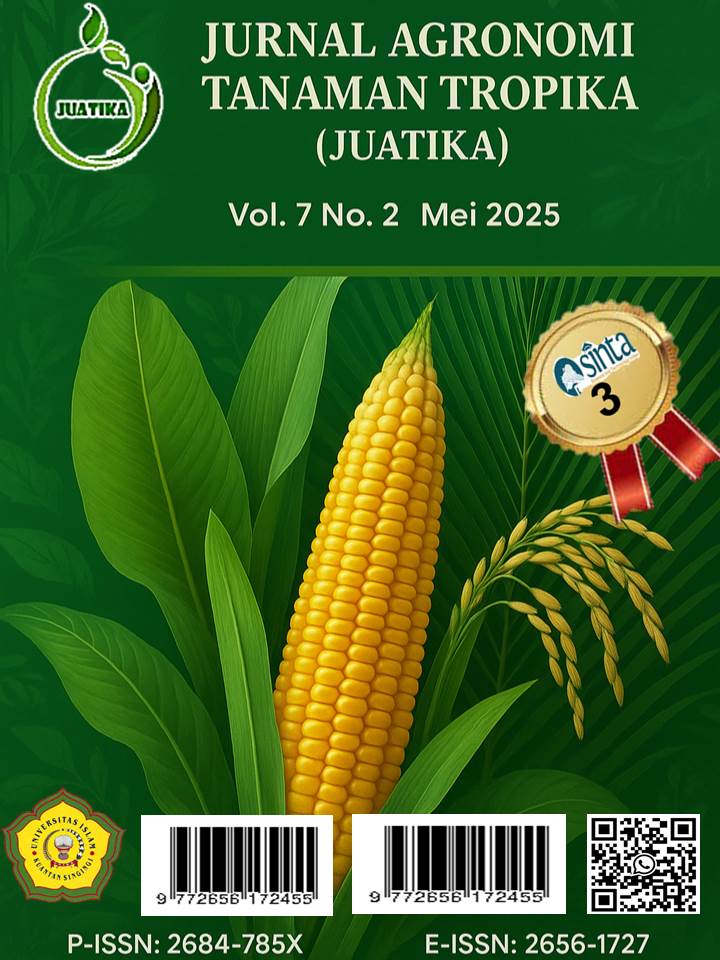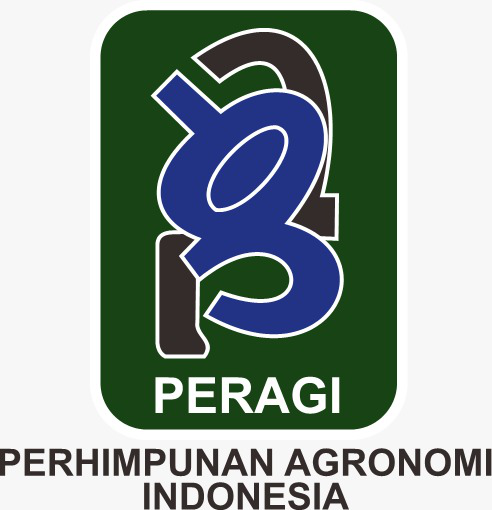Evaluation of Tolerance of Several Corn Genotypes (Zea mays L.) to Salinity Stress at the Germination Stage
Abstract
Corn (Zea mays L.) is a vital food crop with the potential to enhance food supply and support other sectors, such as livestock production. This study aims to determine the level of salinity stress that can be utilized to select maize genotypes tolerant to such stress. The research was conducted in the greenhouse of the Maros Cereal Research Center (Balitsereal) starting in February. The experimental design employed a split-plot arrangement consisting of two factors. The main plot consisted of five levels of NaCl concentration: no salinity stress and concentrations of 30, 60, 90, and 120 mM. The subplot included eight maize genotypes. Each treatment combination was replicated three times. Corn seeds were germinated for five days in petri dishes lined with germination paper, with ten seeds per dish. Afterward, the seeds were treated with NaCl and distilled water. The germinated seeds (after 5 days) were then transferred to the next germination medium, specifically styrofoam. At the germination stage, the tolerance selection of several corn genotypes under salinity stress revealed that NaCl concentration significantly affected plumule length, root length, and the number of roots. As the NaCl concentration increased, plumule length, root length, and the number of roots decreased. Additionally, genotype significantly impacted root length, the number of roots, and the percentage of seed growth. The results of the variance analysis indicated that there was no interaction between NaCl concentration and genotype at the germination stage.
Downloads
References
Ahmad, I., Kanwal, S., Rasheed, A., et al. (2021). Differential response of maize genotypes under saline conditions: A physiological and biochemical approach. Physiology and Molecular Biology of Plants, 27, 67–77. https://doi.org/10.1007/s12298-020-00907-3
Badan Pusat Statistik (BPS). (2015). Data produksi tanaman pangan. Direktorat Jenderal Tanaman Pangan. http://www.pertanian.go.id/ap_pages/mod/datatp (DiakseS20 Juli 2016)
Carpýcý, E., Celýk, N., & Bayram, G. (2009). Effects of salt stress on germination of some maize (Zea mays L.) cultivars. African Journal of Biotechnology.
Cramer, G. R. (2002). Sodium-calcium interaction under salinity stress. University of Nevada, USA.
Dachlan, A. (2013). Uji ketahanan salinitas beberapa varietas jagung (Zea mays L.) dengan menggunakan agen seleksi NaCl (Skripsi). Fakultas Pertanian, Universitas Hasanuddin.
Hussain, S., Khan, M. A., Ahmad, W., et al. (2019). Evaluating the impact of salinity stress on seed germination and seedling growth of maize genotypes. Journal of Plant Nutrition, 42(4), 425–439. https://doi.org/10.1080/01904167.2018.1554680
Ismail, I. (1998). Peranan Na dan substitusi parsial KCl oleh NaCl dalam pertumbuhan dan produksi tebu (Saccharum officinarum L.) serta pengaruhnya terhadap sifat kimia tanah (Disertasi). Program Pascasarjana, IPB, Bogor.
Jumin, H. B. (2002). Agroekologi: Suatu pendekatan fisiologis. Raja Grafindo Persada.
Khan, A. M., & Rizvi, Y. (1997). Effect of salinity, temperature and growth regulators on the germination and early seedling growth of Atriplex griffthii. Canadian Journal of Botany, 72, 475–479.
Latif, M., Saleem, M. F., Cheema, M. A., Khan, H. Z., & Ahmad, M. S. A. (2015). Interactive effect of salinity and nitrogen on growth and yield of maize (Zea mays L.). Soil and Environment, 34(1), 52–57.
Mohammad, M. I. H., Jun, Z., & Guoying, W. (2014). Impact of salinity stress on seed germination indices of maize (Zea mays L.) genotypes. Kragujevac Journal of Science, 36, 155–166.
Mostafavi, K. (2011). An evaluation of safflower genotypes (Carthamus tinctorius L.), seed germination and seedling characters in salt stress conditions. African Journal of Agricultural Research, 6(7), 1667–1672.
Motsa, M. M., Slabbert, M. M., Van Averbeke, W., & Morey, L. (2017). Effect of salinity on germination and seedling growth of selected African leafy vegetables. South African Journal of Botany, 109, 111–117. https://doi.org/10.1016/j.sajb.2016.11.006
Nugraheni, I. T., Solichatun, & Anggarwulan, E. (2003). Pertumbuhan dan akumulasi prolin tanaman orok-orok (Crotolaria juncea L.) pada salinitas CaCl₂ berbeda. BioSMART, 2, 1.
Sarah. (2014). Analisis dampak ekonomi dari alih fungsi lahan pertanian ke non-pertanian terhadap ketahanan pangan. Bogor.
Copyright (c) 2025 Sion Oktafianus, Sepsriyanti Kannapadang, Driyunitha

This work is licensed under a Creative Commons Attribution 4.0 International License.
Authors who publish with Jurnal Agronomi Tanaman Tropika (JUATIKA) agree to the following terms:
Authors retain copyright and grant the Jurnal Agronomi Tanaman Tropika (JUATIKA) right of first publication with the work simultaneously licensed under a Creative Commons Attribution License (CC BY 4.0) that allows others to share (copy and redistribute the material in any medium or format) and adapt (remix, transform, and build upon the material for any purpose, even commercially) with an acknowledgment of the work's authorship and initial publication in Jurnal Agronomi Tanaman Tropika (JUATIKA).
Authors are able to enter into separate, additional contractual arrangements for the non-exclusive distribution of the journal's published version of the work (e.g., post it to an institutional repository or publish it in a book), with an acknowledgment of its initial publication in Jurnal Agronomi Tanaman Tropika (JUATIKA). Authors are permitted and encouraged to post their work online (e.g., in institutional repositories or on their website) prior to and during the submission process, as it can lead to productive exchanges, as well as earlier and greater citation of published work.







 More Information
More Information



